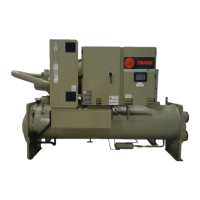RTHD-SVX01L-EN
67
Maintenance
WARNING
Hazardous Voltage w/Capacitors!
Failure to disconnect power and discharge capacitors
before servicing could result in death or serious
injury.
Disconnect all electric power, including remote
disconnects and discharge all motor start/run
capacitors before servicing. Follow proper lockout/
tagout procedures to ensure the power cannot be
inadvertently energized. For variable frequency drives
or other energy storing components provided by
Trane or others, refer to the appropriate
manufacturer’s literature for allowable waiting periods
for discharge of capacitors. Verify with a CAT III or IV
voltmeter rated per NFPA 70E that all capacitors have
discharged.
This section describes the basic chiller preventive
maintenance procedures, and recommends the intervals at
which these procedures should be performed. Use of a
periodic maintenance program is important to ensure the
best possible performance and efficiency from a Stealth™
chiller.
Use an Operator Log (see “Log and Check Sheets,” p. 85)
to record an operating history for unit. The log serves as a
valuable diagnostic tool for service personnel. By observing
trends in operating conditions, an operator can anticipate
and prevent problem situations before they occur.
If unit does not operate properly during inspections, see
“Diagnostics,” p. 72.
Recommended Maintenance
Weekly
While the unit is running in stable conditions:
• Log the chiller.
• Check evaporator and condenser pressures with
gauges and compare to the reading on the Tracer
AdaptiView™ TD7 or Tracer® TU service tool.
Pressure readings should fall within operating ranges
specified in Table 16, p. 68 and . If chiller
measurements vary significantly from values listed in
Table 16, p. 68 and , problems may exist with
refrigerant and oil charge levels. Contact local Trane
service.
Note: Optimum condenser pressure is dependent on
condenser water temperature, and should equal
saturation pressure of refrigerant at a
temperature 2 to 5°F above that of leaving
condenser water at full load.
Monthly
• Review operating log.
• Clean all water strainers in both the chilled and
condensing water piping systems.
• Measure and log the subcooling and superheat.
• See “Refrigerant and Oil Charge Management,” p. 67.
If chiller measurements vary significantly from values
listed in Table 16, p. 68 and , problems may exist with
refrigerant and oil charge levels. Contact local Trane
service.
Annual
Shut down the chiller once each year to check the
following:
• Perform all weekly and monthly maintenance
procedures.
• Have a qualified laboratory perform an oil analysis to
determine system moisture content and acid level.
Important: Due to the hygroscopic properties of the
POE oil, all oil must be stored in metal
containers. The oil will absorb water if
stored in a plastic container.
• Contact Trane service to leak check the chiller, inspect
safety controls, and inspect electrical components for
deficiencies.
• Inspect all piping components for leakage and/or
damage. Clean out any in-line strainers.
• Clean and repaint any areas that show signs of
corrosion.
• Inspect vent piping of all relief valves for presence of
refrigerant to detect improperly sealed relief valves.
Contact Trane service if unusual conditions are
observed.
• Inspect the condenser tubes for fouling. Clean if
necessary. See “Cleaning the Condenser,” p. 68.
• Check to make sure that the oil sump heater is working.
Scheduling Other Maintenance
• Use a nondestructive tube test to inspect the
condenser and evaporator tubes at 3-year intervals.
Note: It may be desirable to perform tube tests on
these components at more frequent intervals,
depending upon chiller application. This is
especially true of critical process equipment.
• Depending on chiller duty, contact Trane service
organization to determine when to conduct a complete
examination of the unit to determine the condition of the
compressor and internal components.
Refrigerant and Oil Charge Management
Proper oil and refrigerant charge is essential for proper unit
operation, unit performance, and environmental protection.
Only trained and licensed service personnel should service
the chiller.

